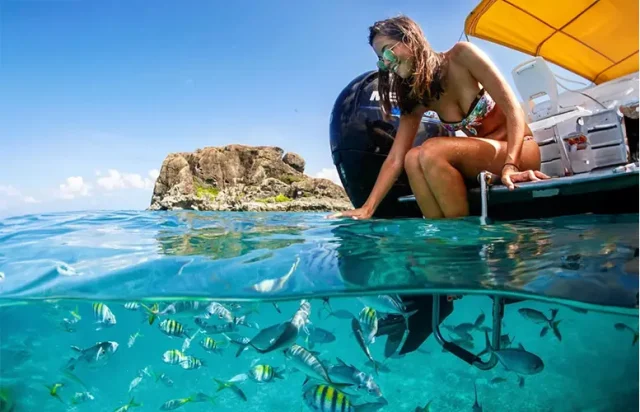
Even amidst the endless blue that surrounds the island of St. Martin, specific locales can’t help but stand out. Whether it be a particularly visually beautiful site or a stretch of sea especially conducive to diving, St. Martin holds many offshore treasures for those in the know. One such treasure, remarkable both in appearance and experience, is the majestic Creole Rock. Nestled just outside the stunning Baie de Grand Case on the French side of St. Martin, Creole Rock awaits adventurous souls looking to explore the underwater wonderland of the Caribbean at their own pace and on their own terms.
This unique and protected piece of land extends from the turquoise Caribbean Sea, making it a popular site for both snorkelers and scuba divers alike. From its unmistakable peak above the water to the secrets beneath the waves, Creole Rock promises an unforgettable aquatic experience. Below, we explore everything (well, almost everything) Creole Rock has to offer. You’ll just have to see the full story for yourself!
Above and Below the Waves
Creole Rock stands as one of the destination’s most prominent landmarks, easily visible from the beach, and a natural contrast to manmade sites like Fort St. Louis. It is recognizable by its distinctive shape, which is said to resemble the head of an Amerindian male. The rock provides a sheltering barrier, protecting swimmers from the winds that sometimes whip up high waves, and drawing plenty of patronage from locals and visitors alike. In that respect, it’s a great place to make new friends among smiling faces – united in a desire to enjoy the tranquil waters.
For divers, circling around the rock’s base is a gateway to explore both sides of this marine wonder. With its shallow waters, Creole Rock caters to both beginners and experienced divers. Snorkelers, too, will find delight in exploring the vibrant sea life without the need to venture into deeper waters. The protection offered by Creole Rock extends to its many avian inhabitants, as brown pelicans, boobies, and many other varieties of tropical birds frequently make nests in this secluded spot.
Enjoying the Rock, Responsibly
Visitors to Creole Rock should note the importance of respecting and protecting its unique ecosystem. According to the guidelines of the Reserve Naturelle Saint Martin, within which Creole Rock sits, stepping foot on Creole Rock itself is prohibited, so as not to disturb the nesting birds. Boats entering this environmentally protected area must also use the designated moorings, which are typically reserved for boats from dive clubs, chartered sailing tours, and smaller sailboats.
Getting the Most Out of Your Visit
While Creole Rock is naturally a popular destination for divers and snorkelers, there’s a little trick to avoid the crowds. Most visitors tend to congregate around the “head” of the formation, where a concentration of fish can be found beneath the waves. However, for a quieter experience, head to the lowest-lying part (the “feet”) of Creole Rock, where the surrounding coral is in pristine condition. Here, you’ll commonly encounter schools of spirited tropical fish flitting about amidst the marine landscape.
For those seeking a seamless and enriching experience at Creole Rock, book a guided snorkeling tour. Most of the boat rental and jet ski companies in the area offer dedicated day trips to the Rock – an attractive, stress-free option that you can pair with complimentary cocktails. Expert guides will not only lead you to the best snorkeling spots but also provide valuable insights into marine life and the history of Creole Rock. They ensure your safety and environmental responsibility while allowing you to fully immerse yourself in this aquatic wonderland.
Explore Creole Rock with a knowledgeable guide and discover the hidden treasures that await beneath the waves. For more information on St. Martin, visit https://www.st-martin.org/us/





